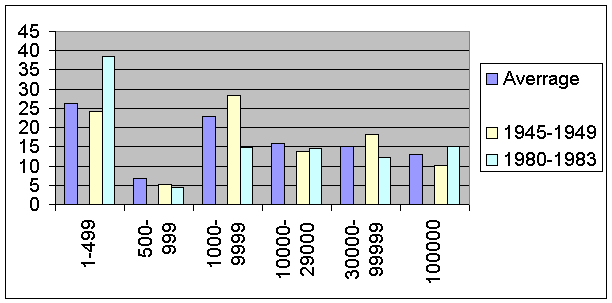1.- Size of firm and Innovation
There is a debate over the size of the firms and their role in innovation. Some economists have argued for their importance of large size and monopoly power, while some others have argued for small size firms. The size of a firm is not clear that is correlated with the innovatory advantage. We are going to point advantages and disadvantages of small and large firms in innovation.
Small and medium-sized enterprises (SMEs
1):At a management level, small firms have little bureaucracy, they are rapid decision-making and risk-taking, but entrepreneurial managers often lack formal management skills. In communication SMEs have rapid and effective internal communication and formal networks although there could be a lack of time and resources create and maintain external relationships.
SMEs have fast reaction to changing market niches but the market start-up abroad can be prohibitively costly. SMEs technical personnel are well plugged in to other departments although they often lack high-level technical skills. Full time R&D can be too costly, although innovation can be sometimes less costly in SMEs, because R&D can be more efficient. On the other hand innovation represents a large financial risk. SMEs cannot spread risk. Accessing external capital for innovation can be a problem and the cost of capital can be relatively high. Although SMEs have a potential for growth through “niche strategy”, (differentiation strategy) they face problems in accessing external capital for growth.
Besides last regulations sometimes applied less stringently to SMEs and many schemes have been established by Governments to assist their innovation. But accessing government schemes can be difficult and SMEs often cannot cope with complex regulations, and they are sometimes unable to cope with patenting system and face a high opportunity cost in defending patents.
In large firms professional managers are able to control complex organizations and establish corporate technology strategies. However, large firms are often controlled by risk-averse accountants, and managers become bureaucrats and have a lack in dynamism. Another disadvantage is that internal communication can be cumbersome and their long decision chains result in slow reaction times. Large firms can ignore emerging market niches with growth potential, although they have comprehensive distribution and servicing facilities and a high market power with existing products, which are marketing advantages.
Large firms are able to attract highly skilled specialist and can support the establishment of a large R&D laboratory. And what it’s really important they can take advantage of economies of scale and scope in R&D. Nevertheless their technical manpower can become isolated from other corporate functions.
At a finance level, large firms are able to borrow and can spread risk over several products. But shareholders pressures can force a focus on short-term profits. Large firms are able to obtain scale and learning curve economies through investment in production, they can fund growth via acquisition and can gain price leadership. For large firms regulation often is applied more stringently. They are able to defend patents and can employ specialist to assist in accessing government schemes, although.
Large firms can encourage innovative suppliers while SMEs can exert little control over them.
The innovatory advances of large firms are mainly associated with their relatively greater financial and technological resources, which are material advantages. SMEs advantages are those of entrepreneurial dynamism, internal flexibility and responsiveness to changing circumstances, which are behavioural advantages.
Although there are not so many researches showing nationally produced innovations by size of firm, we found th Science Policy Research Unit’s (SPRU) innovation database (UK). This database contains details on some 4,400 significant innovations introduced into commercial use by British companies between 1945 and 1983 (Townsend, 1981)
Graph 1, below, is based on SPRU data, for the periods 1945-49 and 1980-83 the share of innovations gainded by firms in six size categories. Maybe the most notable feature of the data is the increasing share of national innovations taken by small and medium-sized enterprises. The innovation share increased from 24.3 per cent during 1945-49, to 38.4 per cent during 1980-83.

|
|
1-499 |
500-999 |
1000-9999 |
10000-29000 |
30000-99999 |
100000 |
|
|
|
|||||
|
Averrage |
26.4 |
6.8 |
22.9 |
15.8 |
15.1 |
13 |
|
|
|
|
|
|
|
|
|
1945-1949 |
24.3 |
5.3 |
28.3 |
13.7 |
18.1 |
10.2 |
|
1980-1983 |
38.4 |
4.3 |
14.9 |
14.6 |
12.1 |
15.2 |
Contribution of SMEs firms to innovation varies considerably between sectors of industry. In general, where capital and/or R&D requirements and other entry cost are high, small firms’ share has been small, and vice versa.
The case of electronic computers is interesting since it illustrates clearly the necessity for adopting a dynamic approach to the question of firm size and innovation. For most of the period up to 1970, SMEs share of innovations in this area was relatively small or zero. Between 1970 and 1983, however, SMEs’ share increased dramatically form 36 per cent during 1970-74, to 47 per cent during 1975-79 and even to 64 per cent during 1980-83. During the 1950s and 1960s, UK production was composed almost entirely of mainframe computers with associated high R&D, manufacturing and servicing cost, which was an entry barrier for SMEs. With the introduction of microprocessor, entry by SMEs became entirely possible. They rapidly became involved in the production of micro-computers and peripherals to satisfy the many new market segments that emerged. Thus, while one type of technology might effectively prevent significant participation by SMEs, another can present them with many new product-market opportunities, such as the software sector.
Large firms have frequently diversified through a process of small firms acquisition, as a way to combine both material and behavioural advantages, in order to facilitate their movement into new areas of activity. Small firms innovation advantage, in general tended to occur in highly innovative industries where the use of skilled labour is relatively important.
Innovatory advantage is unequivocally associated with neither large nor small firms. Small firms advantages are mainly behavioural while those of large firms are mainly material. Small firms’ innovatory contribution varies significantly from sector to sector. Small and medium firms’ main contribution is in sectors where entry costs are not too high, niche markets exists, and where the use of skilled labour is relatively important.
Some economists have discussed for the importance of large size and monopoly powers over industrial innovation, perhaps most notably Schumpeter. In the following chapter we will develop his views.
1 (SMEs - firms employing under 500 people)

